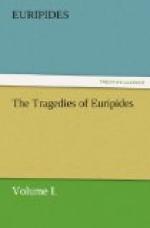[46] Beck, by putting the stop after [Greek: petron], makes [Greek: hypodromon] to agree with [Greek: kolon], “his limb diverted from its tread.”
[47] The construction is [Greek: phonos krantheis phonoi]: [Greek: aimati] depends on [Greek: en] understood.
[48] Most MSS. have [Greek: xynetos]. Here then is a remarkable instance of the same word having both an active and a passive signification in the same sentence.
[49] [Greek: makropnoun], not [Greek: makropoun], is Porson’s reading, [Greek: makropnous zoe] is explained “vita in qua longo tempore spiratur; ergo longa.”
[50] See note at Hecuba 65.
[51] The old reading was [Greek: ti tlas; ti tlas;] making it the present tense. Brunck first edited it as it stands in Porson. Antigone repeats the last word of her father.
* * * *
ADDITIONAL NOTES.
* * * *
[A] “Signum interrogandi non post [Greek: neanias], sed post [Greek: lochagos] ponendum. [Greek: lochagos] in libris pedagogo tribuitur: quod correxit Hermannus.” DINDORF.
[B] Porson and Dindorf (in his notes) favor Reiske’s conjecture, [Greek: pyknoisi] for [Greek: pyrgoisi].
[C] Dindorf rightly approves the explanation of Musgrave, who takes [Greek: stephanoisi], like the Latin corona, to mean the assemblies. He translates: “nec in pulchros choros ducentibus circulis juventutis.”
[D] The full sense, as laid down by Schoefer and Dindorf, is, “for ever when an old man travels, whether in a carriage, or on foot, he requires help from others.” [Greek: pasa apene pous te] is rather boldly used, but is not without example.
[E] i.e. “you ask a thing (i.e. your son’s safety) dangerous to the city, which you can not preserve.” SCHOEFER.
[F] These three lines are condemned by Valck. and Dind.
[G] Matthiae attempts to explain these words as follows: “[Greek: empyroi akmai] may be put for [Greek: ta empyra], in which the seers observed ([Greek: enomon]) two things, viz. the divisions ([Greek: rhexeis]) of the flame, which, if it slid round the altars, was of ill omen (hence [Greek: hygrai], i.e. gliding gently around the altars with many curves, for which is put [Greek: hygrotes enantia]); and 2dly, the upright shooting of the flame, [Greek: akran lampada].”
[H] See Dindorf on Orest. 1691. He fully condemns these lines as the work of an interpolator. They are, however, as old as the days of Lucian.
* * * * * *
MEDEA.
* * * *
PERSONS REPRESENTED.
NURSE.
TUTOR.
MEDEA.
CHORUS OF CORINTHIAN WOMEN.
CREON.
JASON.
AEGEUS
MESSENGER.
SONS OF MEDEA.
The Scene lies in the vestibule of the palace of Jason at Corinth.




